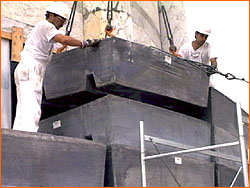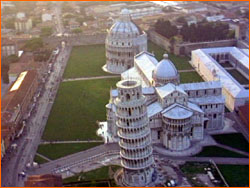
|
 |
 |
History of Interventions Part 2 | Back to Part 1 1985 Ten arc seconds are added to the tilt after boring both into the masonry foundations and accidentally into the soil beneath them. 1990 With the tower continuing to tilt naturally at the rate of a little over five arc seconds per year, the Italian government closes the Leaning Tower of Pisa, sparking outrage by Pisan officials, who fear the loss of tourist revenue and the resulting impact on the local economy. The closure was provoked by the collapse of the civic tower of Pavia in 1989, which raised fears for the safety of the Pisa tower.
The Pisa Commission stabilizes the masonry by wrapping plastic-coated steel tendons around the tower up to the second story. This closes many cracks and reduces the chance of a buckling collapse. 1993-1994 Workers pour a temporary concrete ring around the base of the tower to serve as a foundation upon which to lay lead counterweights on the north side. Between May 1993 and January 1994, crews lay down a series of specially cast lead ingots. By July 1994, the tower has leaned back toward the north - the desired direction—a full 52 arc seconds. 1995 After deciding to replace the unsightly lead counterweights with an anchored cable system, the Pisa Commission begins freezing the ground with liquid nitrogen in preparation for installing the cables. As soon as the freezing stops, however, the tower begins to lean south at a rate of four arc seconds per day. This begins in the middle of a September night, which Commission members will come to remember as "Black September." The operation is immediately halted, and the search for a permanent solution continues with new urgency. 1996 In March, engineers successfully complete a test of a soil-extraction method to reduce the tower's lean. The method calls for an inclined drill, which creates cavities that gently close due to the pressure of the overlying soil. For various political reasons, however, actual soil extraction does not get underway for almost three years. 1998 In December engineers install temporary cables, which can be tensioned to steady the tower if detrimental movements occur during stabilization efforts.
In February, engineers begin a very careful process of soil extraction. Using a dozen boreholes over a width of only about 18 feet, they remove underlying soil at an extremely conservative pace of about five gallons every two days. By mid-June, the tower has leaned back toward the north by 90 arc seconds, equivalent to about one inch at the top, and it continues to move ever so slowly in a northward direction. By the end of August the lean had decreased by 130 arc seconds (1.5 inches). The response of the Tower to preliminary soil extraction has been so positive that on September 14th workers removed three of the lead weights in anticipation of the eventual, progressive removal all the ingots during full underexcavation. The next step will be for the Commission to formally approve a full soil-extraction intervention to permanently stabilize the tower (see Where It Stands Today). Timeline compiled by NOVA Online Intern Sarah Ince. Principal sources Dr. John Burland www.endex.com/gf/buildings/ltpisa.html www.xs4all.nl/~pisa0/index1.html www.columbia.edu/~jhb3/project/pisa/pisa.html Pisa Panorama | Where it Stands Today | The Galileo Games Rescuing World Monuments | History of Interventions | Resources Teacher's Guide | Transcript | Site Map | Fall of the Leaning Tower Home Editor's Picks | Previous Sites | Join Us/E-mail | TV/Web Schedule About NOVA | Teachers | Site Map | Shop | Jobs | Search | To print PBS Online | NOVA Online | WGBH © | Updated November 2000 |
 In the mid-1990s, lead blocks like these helped pull
the tower over half an inch closer to vertical at the
top - a significant amount to engineers.
In the mid-1990s, lead blocks like these helped pull
the tower over half an inch closer to vertical at the
top - a significant amount to engineers.
 With the help of advanced techniques of intervention,
officials will hopefully leave the Leaning Tower of
Pisa leaning safely for centuries to come.
With the help of advanced techniques of intervention,
officials will hopefully leave the Leaning Tower of
Pisa leaning safely for centuries to come.